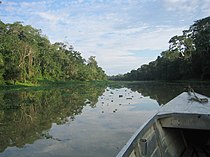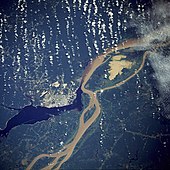Blackwater river

A blackwater river is a type of
Blackwater rivers are lower in nutrients than whitewater rivers and have ionic concentrations higher than rainwater.[1][2] The unique conditions lead to flora and fauna that differ from both whitewater and clearwater rivers.[3] The classification of Amazonian rivers into black, clear, and whitewater was first proposed by Alfred Russel Wallace in 1853 based on water colour, but the types were more clearly defined by chemistry and physics by Harald Sioli from the 1950s to the 1980s.[3][4] Although many Amazonian rivers fall clearly into one of these categories, others show a mix of characteristics and may vary depending on season and flood levels.[5]
Comparison between white and black waters
| Solimões or Amazon River – whitewater |
Rio Negro – blackwater | |
|---|---|---|
| Na (mg/L) | 2.3 ± 0.8 | 0.380 ± 0.124 |
| K (mg/L) | 0.9 ± 0.2 | 0.327 ± 0.107 |
| Mg (mg/L) | 1.1 ± 0.2 | 0.114 ± 0.035 |
| Ca (mg/L) | 7.2 ± 1.6 | 0.212 ± 0.066 |
| Cl (mg/L) | 3.1 ± 2.1 | 1.7 ± 0.7 |
| Si (mg/L) | 4.0 ± 0.9 | 2.0 ± 0.5 |
| Sr (μg/L) | 37.8 ± 8.8 | 3.6 ± 1.0 |
| Ba (μg/L) | 22.7 ± 5.9 | 8.1 ± 2.1 |
Al (μg/L)
|
44 ± 37 | 112 ± 29 |
| Fe (μg/L) | 109 ± 76 | 178 ± 58 |
| Mn (μg/L) | 5.9 ± 5.1 | 9.0 ± 2.4 |
| Cu (μg/L) | 2.4 ± 0.6 | 1.8 ± 0.5 |
| Zn (μg/L) | 3.2 ± 1.5 | 4.1 ± 1.8 |
Conductivity
|
57 ± 8 | 9 ± 2 |
| pH | 6.9 ± 0.4 | 5.1±0.6 |
| Total P (μg/L) | 105 ± 58 | 25 ± 17 |
| Total C (mg/L) | 13.5 ± 3.1 | 10.5 ± 1.3 |
HCO3 -C (mg/L)
|
6.7 ± 0.8 | 1.7 ± 0.5 |
Black and
Black and white waters differ in their
| Animal groups present |
Black water |
Mixed water |
White water |
|---|---|---|---|
| Rotifera | 284 | 23 | 0 |
Cladocera
|
5 | 29 | 43 |
| Ostracoda | 39 | 97 | 29 |
| Calanoida | 11 | 51 | 66 |
| Cyclopoida | 22 | 49 | 61 |
| Chironomidae | 0 | 3 | 3 |
Acari (mites)
|
0 | 0 | 2 |
| Black water | Mixed water | White water | ||||
|---|---|---|---|---|---|---|
| Animal groups present |
Open water |
Forest | Open water |
Forest | Open water |
Forest |
| Volvocaceae | 42 | 38 | ||||
| Rotifera | 87 | 5 | 34 | |||
Cladocera
|
6 | 5 | 8 | 1 | ||
| Ostracoda | 2 | 11 | 3 | 7 | ||
| Calanoida | 23 | 3 | 10 | |||
| Cyclopoida | 5 | 27 | 19 | 1 | 13 | 1 |
| Mysidacea | 1 | |||||
Diptera
|
1 | |||||
Acari (mites)
|
1 | 1 | ||||
| Larval fish | 1 | 1 | ||||
Comparison between clear and black waters
Blackwater rivers resemble
Blackwater rivers of the world
This section needs additional citations for verification. (January 2021) |
Amazonia
- Apaporis River: a tributary of the Japurá River
- Tapajós River
- Coari River
- Mazaruni River
- Mirití-Paraná River
- Piorini River
- Potaro River: a tributary of the Mazaruni River
- Rio Negro: The largest blackwater river in the world; one of the largest Amazonian tributaries.
- Tahuayo River
- Tefé River
- Uatumã River
- Urubu River
- Vaupés River
Orinoco basin
- Morichal Largo River
- Caroní River: from the Guiana Highlands of Venezuela north into the Orinoco.
- Caura River: from the Guiana Highlands of Venezuela north into the Orinoco
- Inírida River: from Colombia northeast into the Guaviare River which flows into the Orinoco
- Ventuari River: from eastern Venezuela southwest into the Orinoco
- Vichada River: from Colombia east into the Orinoco
- Tomo River: from Colombia east into the Orinoco
- Tuparro River: from Colombia east into the Orinoco
Southern United States

- Ashepoo River: along with the Edisto and the Combahee Rivers in South Carolina makes up the ACE Basin National Wildlife Refuge.
- Big Cypress, Black Cypress, and Little Cypress and the small rivers in the watershed of Caddo Lake in Texas and Louisiana
- Blackwater River: a tributary of the Chowan Riverin Virginia
- Blackwater River: a major river in the western Florida panhandle
- Blackwater River, West Virginia: Located in the Blackwater Canyon in Tucker County. Blackwater Falls, a five-story waterfall, is located along this river with rapids ranging from Class III-V+.
- Black River: a tributary of the Pee Dee River in North and South Carolina
- Cape Fear River, North Carolina: flows into the Atlantic Ocean.
- Cashie River, North Carolina: flows into Albemarle Sound.
- Caloosahatchee River, Florida: flows west from Lake Okeechobee to the Gulf of Mexico.
- Chowan River, North Carolina: flows into Albemarle Sound.
- Edisto River, South Carolina: flows into the Atlantic Ocean.
- Econlockhatchee River, a tributary of the St. Johns River in Central Florida.
- Forked Deer River: located in West Tennessee
- Four Hole Swamp, a tributary of the Edisto River in South Carolina.
- Little Manatee River, Florida: flows into Tampa Bay.
- Great Coharie Creek, North Carolina: flows into the Black River.
- Little Pee Dee River, South Carolina: flows into the Pee Dee River.
- Lynches River, South Carolina: flows into the Pee Dee River.
- Drowning Creek: located in North and South Carolina. Part of Lumber River State Park
- Myakka River: 66 mile-long river with its headwaters in Manatee County, Florida. The Myakka River discharges into Charlotte Harbor.
- Obion River: located in Northwest Tennessee
- Ochlockonee River: a river in northern Florida
- Ogeechee River: a 245-mile river in eastern Georgia that passes to the south of the city of Savannah and enters the Atlantic Ocean at Ossabaw Sound.
- Ohoopee River: a 119-mile-long (192 km) river in east-central Georgia. It is a tributary of the Altamaha River, which flows to the Atlantic Ocean.
- Elizabeth City.
- Peace River: located in central Florida, flows into Charlotte Harbor.
- Pithlachascotee River: a small river in central Florida
- Pocomoke River: a river in southern Delaware and southeastern Maryland on the Delmarva Peninsula. The river is a tributary to the Chesapeake Bay.
- Santa Fe River: a river in northern Florida
- Satilla River: a river in southeast Georgia that flows through the city of Waycross and empties into the Atlantic Ocean near Cumberland Island.
- Scuppernong River: a small river in Washington and Tyrrell Counties in eastern North Carolina at Pettigrew State Park
- Sopchoppy River: a river in northern Florida
- St. Mary's River (Florida–Georgia): a 130-mile river located in southeast Georgia and is bordered by the Satilla River Basin to the north and the Suwannee River Basin to the west.
- St. Johns River: The largest river in Florida. Flows north through Jacksonville and into the Atlantic.
- St. Sebastian River, Indian River County, Florida.
- Suwannee River: a large river in southern Georgia and northern Florida flowing into the Gulf of Mexico
- Upper Little River, North Carolina: flows into the Cape Fear River.
- Upper Nanticoke River, Delaware and Maryland: flows into the Chesapeake Bay.
- Village Creek, a 63 Mile long stream in the Big Thicket region of southeast Texas: flows into the Neches River.
- Waccamaw River, North and South Carolina: flows into the Atlantic Ocean.
- White Oak River, North Carolina: flows into the Atlantic Ocean.
- Wolf River: arises in Northern Mississippi and runs through southwest Tennessee/Memphis into Mississippi River
Northern United States

- Adirondacks that flows into Lake Ontario.
- National Wild and Scenic River.
- Pine Barrens, New Jersey, where the dark water is called cedar water
- Gooseberry River: a river in northern Minnesota that leaches from peat bogs and pine forests
- Ocqueoc River, Michigan: a river in the northern Lower Peninsula that flows in Lake Huron
- Upper Peninsula that flows into Lake Superior
- Great Egg Harbor
Africa
- Most Congo and Lower Guinean rivers that flow through rainforests are blackwater.[10]
- The Congo basin lakes Mai-Ndombe and Tumba are blackwater.[11]
- The Niger River Delta) are blackwater.[12]
Australia
- Gordon River, Tasmania: a river rising in the center of the island and flowing westward, emptying into Macquarie Harbour on the West Coast
- Pieman River, Tasmania: a river on the West Coast which leaches from rainforests and heathlands
- Davey River, Tasmania: a relatively small river in the southwest corner of the island which runs through extensive heathlands, peat bogs and button grass plains
- Noosa River, Queensland: a small section of the Noosa River running between Lake Cootharaba and Lake Cooroibah[13]
- Searys Creek, Queensland: a small river running from the Great Sandy National Park to Tin Can Bay stained with tea-tree tannin.
Intermittent blackwater events
Other rivers in Australia may experience infrequent 'blackwater events' associated with flood waters connecting to forested floodplains and these events may be associated with hypoxic waters [low oxygen]. Examples include the Murray River, Edward River, Wakool River and Murrumbidgee River.[14]
Indonesia
- Sabangau River
- Kapuas River
Images of blackwater rivers
-
Amazon tributary classified as blackwater
-
Cluster ofbald cypress trees in Trap Pond State Park in Southern Delaware
-
Manaus, the largest city on the Amazon River, from a NASA satellite image, surrounded by the muddy Amazon river and the blackwater Rio Negro
-
A cypress slough where baygall blackwater (left) mixes with the more typical muddy waters (right) of the region. Big Thicket National Preserve, Jack Gore Baygall Unit, Hardin Co. Texas; 3 April 2020
-
Caño Ceima Cachivera, Mitú, Vaupés: one of the most visited waterfalls and indigenous communities In Mitú, Colombia
See also
References
- JSTOR 2989823.
- ^ Sioli, Harald (1975). "Tropical rivers as expressions of their terrestrial environments". Tropical Ecological Systems/Trends in Terrestrial and Aquatic Research. New York City: Springer-Verlag: 275–288.
- ^ a b c Duncan, W. P.; Fernandes, M. N. (2010). "Physicochemical characterization of the white, black, and clearwater rivers of the Amazon Basin and its implications on the distribution of freshwater stingrays (Chondrichthyes, Potamotrygonidae)" (PDF). PanamJAS. 5 (3): 454–464. Archived from the original on 13 November 2021.
- ISBN 978-94-009-6544-7.
- .
- ^ a b c Ribeiro, J. S. B.; Darwich, A. J. (1993). "Phytoplanktonic primary production of a fluvial island lake in the Central Amazon (Lago do Rei, Ilha do Careiro)". Amazoniana. 12 (3–4). Kiel: 365–383.
- ^ "Comparison between white and black waters". Amazonian Fishes and their Habitats. Pisces Conservation Ltd. Archived from the original on 16 July 2011. Retrieved 21 May 2006.
- ISBN 0-8120-4669-2.
- S2CID 36001397.
- ISBN 978-2-8317-1326-7.
- .
- ISBN 1-55963-365-4.
- ^ "Noosa River Elanda Point to Campsite Fifteen Canoe Guidebook". www.upstreampaddle.com. Archived from the original on 8 July 2020. Retrieved 19 November 2014.
- ^ "Black water event in the Murray, Murrumbidgee and Lower Darling River catchments: March 2012". www.dpi.nsw.gov.au. Archived from the original on 8 August 2014. Retrieved 8 August 2014.





